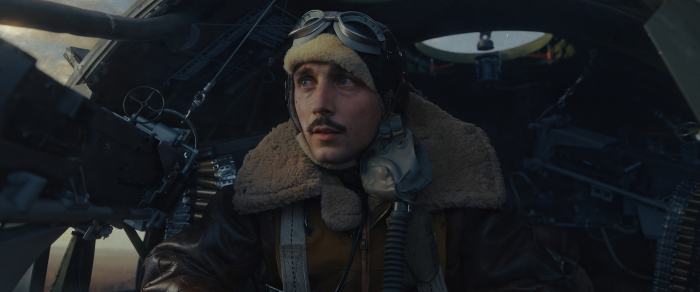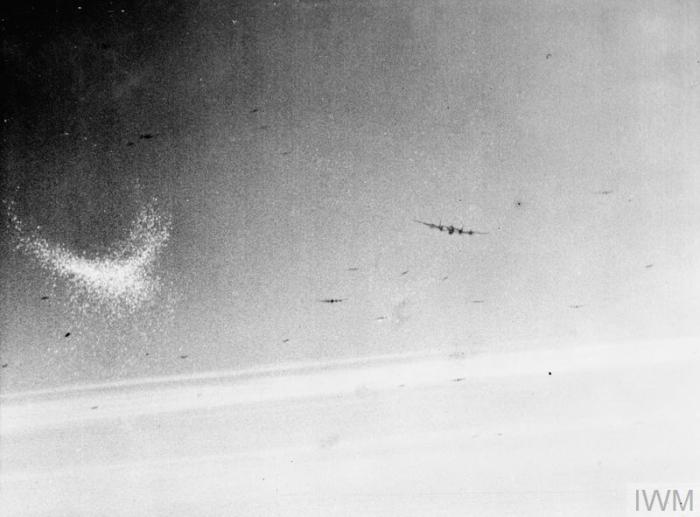By Dr Luke Truxal
Editorial note: On 26 January 2024, Apple TV+ launched the much-anticipated series Masters of the Air. This series follows the actions of the US 100th Bomb Group during the Combined Bomber Offensive in the Second World War. As the series is being aired, our Book Reviews Editor, Dr Luke Truxal, the author of Uniting against the Reich (2023), will critically review each episode.
With only one more episode left, Masters of the Air turned in another disappointing performance in episode eight. The poor pacing of episode seven and, to some degree, episode six has forced the show into a dilemma, namely, what to cover in the final episodes. The showrunners have now decided to cover the significant events of the summer, fall, and early winter of 1944 that shaped the lives of the US 100th Bomb Group, the 332nd Fighter Group, and the prisoners at Stalag Luft III in just 51 minutes. That is too much to ask of any television series. This episode failed largely due to poor pacing and trying to cover too many topics without going into depth on any of them. As a result, the show gave each storyline a token appearance, and, as such, it lacked the substance of the series’ first five episodes. Given this, one must wonder if this series had been written and filmed with the intent of being a much longer television series and how poorly these subjects were covered.
Episode eight covers three main storylines. For the 100th Bomb Group at Thorpe Abbotts, the focus is Major Harry Crosby’s mental and physical breakdown due to the stress of planning missions that force him to be sent on a four-week leave. The second major plot revolves around the prisoners at Stalag Luft III and their preparations to fight back, escape, or be marched to another camp. Finally, the series introduced a new storyline with only one episode remaining, namely that of the famous 332nd Fighter Group – a unit composed of African-American personnel and more commonly known as the ‘Tuskegee Airmen.’ Even though there are some good moments where the show portrays the real struggles of these men, by grazing the surface of each one of these topics, viewers and historians come away asking for more. Masters of the Air tried to do too much, and this episode and the rest of the series paid the price.
Much of the Crosby plot in this episode focuses on his work as a staff officer and his ultimate breakdown. The lead-up to Operation OVERLORD, the landing in Normandy and, ultimately, the liberation of France, has Crosby working for days without sleep. Crosby narrates himself trying to push through and continue planning missions as he feels the weight of each mission on his shoulders. He consumes coffee like water and even resorts to taking medication to keep himself awake. Eventually, he passes out in front of Lieutenant Colonel John ‘Jack’ Kidd from exhaustion. This ultimately leads the new commander of the 100th Bomb Group, Colonel Thomas Jeffrey, to order Crosby to take a four-week vacation to recharge his batteries. This shows the war’s effect on those serving behind the front lines and involved in planning the conduct of the Second World War. This is something that did not get enough coverage in Band of Brothers or The Pacific. With the notable exception of Kenneth More’s portrayal of Captain Jonathan Shepard in Sink the Bismarck in 1960, this is something not often captured well in war films. However, throughout the Second World War, staff officers played a vital role in the success of their units, and it was not uncommon for those leading from the rear to suffer significant health crises because they quite literally worked themselves to death. Notably, for example, Major General Theodore Roosevelt Jr., the eldest son of the US President, died of a heart attack while serving as the Assistant Division Commander of the US 4th Infantry Division during the fighting in Normandy. Dealing with this issue was a nice addition to the series.
Masters of the Air introduced the story of the 332nd Fighter Group, more commonly known as the ‘Tuskegee Airmen,’ in this episode. There are a host of problems with this plot line. First, telling the story of this all-black fighter group is important, but giving the group only minutes of screen time in the second to last episode of the series does not do their story justice. Either increase the number of episodes to tell the story well or save that story for its separate mini-series. The last-minute addition of the 332nd Fighter Group also created additional problems with this plot. For example, we are never really introduced to the group itself and their previous struggles to get into combat. From training and through participation in the North African and Sicilian Campaigns, black fighter pilots faced an uphill struggle to prove their worth. Furthermore, the group became more widely known for their more conservative escort fighter tactics, leading them to snuggle tightly to the bomber formations. This hallmark of the 332nd Fighter Group contributed to their ability to reduce bomber losses while on escort duty and earned them a sterling reputation throughout the US Army Air Forces (USAAF). This moves us into the key individuals. Colonel Benjamin O. Davis Jr. is never really introduced. His story is critical here.
While the episode focuses on Lieutenants Alexander Jefferson and Richard Macon from the 332nd Fighter Group, they do not receive a proper introduction either. They are flung at us. Finally, the only mission we see is the 332nd providing close air support for Operation DRAGOON, the landings in southern France in August 1944. During this episode, Jefferson and Macon are shot down and then captured by the Germans. They go through the same interrogations that Egan also experienced in episode six. The key difference here is that the Germans used the state of racism in the United States to get Jefferson and Macon to turn on their country. While this fails, it is one of the few hints of these men’s challenges in fighting for their country. Instead of putting a face on racism, Masters of the Air decided to keep it faceless and very much in the background. Once again, this was another missed opportunity. In short, by dedicating so little time to this plot in previous episodes or by not expanding the episode count to tell this story well, we get additional problems. The 332nd Fighter Group’s story is glossed over, key individuals get a footnote, and finally, racism hardly appears in the episode.

At Stalag Luft III, we see the Americans struggle with being cut off from the events of the world and the daily boring, melancholy life that takes over. It is a real struggle for Major John Egan, who wants to do something. Meanwhile, Major Gale Clevan tries to organise men to build a new water well. This leads to a fight between the two officers. Eventually, we see Jefferson and Macon arrive at the camp. When they arrived, some men regarded them as heroes, referring to them as the ‘Red Tails.’ Few American airmen knew of the 332nd Fighter Group besides their tail markings. Most did not know that they were an all-black fighter unit. So, this scene where they are greeted as heroes does not land well. Some American airmen did know about the 332nd Fighter Group, but they arrived later at the camp. Most of the airmen interred at Stalag Luft III were shocked to find that black fighter pilots were flying in the USAAF. This scene seems flung at the viewers without any context, especially considering that viewers never got to see the 332nd Fighter Group fly an escort mission in this episode. As the episode ends at Stalag Luft III, the airmen realise that they must work together to prepare for liberation, execution, a forced march to another camp, or escape. By the end of the episode, the different plot lines introduced in episodes six, seven, and eight finally start coming together to set up the series finale.
Overall, this episode fails because it tries to do too much. It tried to cover much of the fighting in 1944 in a single episode and juggled too many plots. In attempting to cover so many stories, we see the episode fail to introduce new characters, units, and stories well properly. Context is missing a lot of the time with each of these plots. Viewers are zipping from story to story like the fast-forward button has been hit on 1944 so we can get to the end of the war. This left a lot to be desired. One positive aspect of the episode was the analysis of Crosby’s physical and mental breakdown as a staff officer. However, one bright spot, in an episode that gave token coverage to a wide range of important historical events and topics, did not help this episode. Ultimately, the approach taken did not serve the series or the history well. One must wonder if this series was written with more episodes in mind and had been forced to make dramatic cuts at some point during the production process.
Dr Luke Truxal is an adjunct at Columbia State Community College in Tennessee. He completed his PhD in 2018 from the University of North Texas with his dissertation ‘Command Unity and the Air War Against Germany.’ His previous publications include ‘Bombing the Romanian Rail Network’ in the Spring 2018 issue of Air Power History. He also wrote ‘The Politics of Operational Planning: Ira Eaker and the Combined Bomber Offensive in 1943’ in the Journal of Military Aviation History. In addition, Truxal is researching the effectiveness of joint air operations between the Allied air forces in the Second World War. He can be reached on Twitter at @Luke_Truxal.
Header image: Josiah Cross in Masters of the Air. (Source: Apple TV+)















